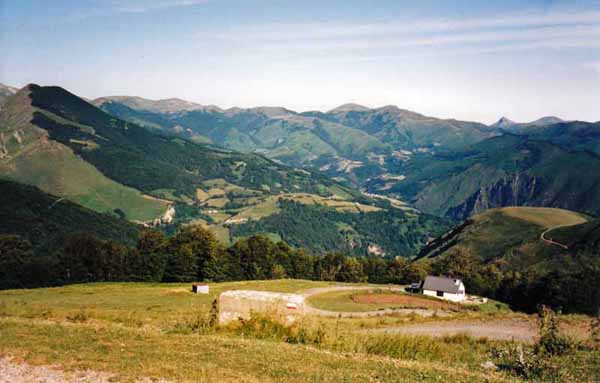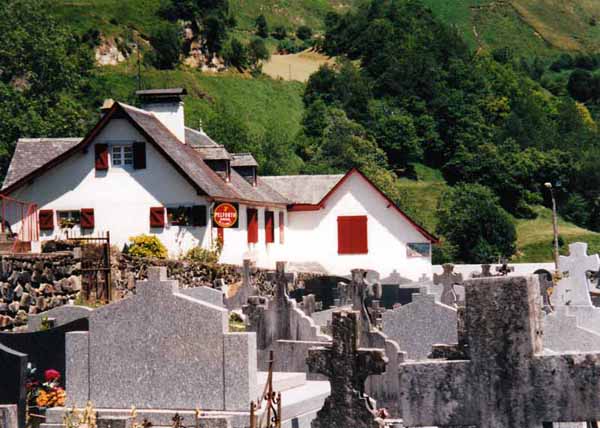Sunday, 22 June 2003
Distance 23 km
Duration 7 hours 5 minutes
Ascent 1354 m, descent 1120 m
Map 69 of the TOP100 blue series (now superseded)
Topoguide (ref. 1086) Pyrénées Occidentales

Poor David was heard sighing exasperatedly during the night and before dawn he got up. Richard’s snoring and the Saturday night revelry outside had given him no rest. He was determined to stay in hotels from now on. We too were up and away early, although we had slept well.
It was barely light just after 6, a state of affairs accentuated by the thick forest we were climbing in. When we came out into the open, it was bright day and we could see Larrau perched on its shelf just across the ravine.
The track continued its brutal ascent, first up a meadow and then in woods again, until it flattened off and became a dirt road.

At first we were pleased with the gentle gradient but it soon became tedious to be wending about seemingly getting nowhere. This was the first time that we met the biting flies of the Pyrenees.
In due course we did arrive at the plateau of Ardakhotchia, as bald as a monk, and here we rested. From there the GR went up a vertiginous grassy ridge. It was all we could do to stay on our feet in the wind. I tied the strings of my beloved yellow hat to my pack and we lurched up like drunkards.
Overhead the vultures and kites circled. It would never do to lie down for a sleep on these hillsides – you would wake up with no eyes.

When we reached a small road, a woman came out of a cottage and told us to follow the road for two kilometres, which was good news, but even then we were almost knocked off our feet by the force of the wind. Below the road was the steepest piece of pasture we had ever seen.
After two kilometres we were looking for the turn-off, when a man in a van stopped and said to go another 400 metres. The locals are very protective of walkers here.
When we finally got to it, the turnoff was well-marked and the featureless grassy slope had a line of posts to show the way up to the col.
Sitting there catching our breath, we saw Nigel, the sturdy Welshman, stumping up towards us. He had taken the long route around the Gorge of Holtzarté and had still caught us, although the only thing he could say as he arrived was “I’m? shattered?” in his lovely Welsh voice.

We had drunk almost all our water by this time, but only a little way down the road on the other side we came to a pipe flowing with icy water from high in the hills. It seemed a good moment for lunch.
We fondly imagined that the hard work of the day was behind us by now, as we could see the scattered houses of Saint-Engrace spread below us. This was not the case, however. The more we descended, the further away our destination seemed to be.
A lot of the way was on the hot, glaring road, which headed in every direction except the one we wanted. In the distance we could see the great bluffs of the Gorges of Kakouéta.
The short-cuts were no better than the road – dank tunnels of foliage choked with loose boulders and full of skinny biting flies.

We were past our best by the time we arrived, via a low bridge, at the main road, where there were parked cars, a couple of drink stalls and Sunday trippers strolling past on their way to the Gorges. This was the nearest thing to a village in the whole valley, which, until the road went in, was known as the End of the World.
At a makeshift kiosk we sat down for a cold Orangina, while the kind owner sprinkled water from a hose on our umbrella and on the hot tar around our feet. We must have looked very poorly.
The last push to the church, although only three kilometres, was relentlessly uphill and exposed to the shrivelling sun.
As we trudged along we saw Nigel coming back towards us, convinced that he was on the wrong road. He was looking for the gîte d’étape but had been confused by a sign to a gîte rural, quite a different thing.

The church was worth the wait. It was old even by French standards, eleventh-century, plain and grim but oddly skewed, with a garden of disc-shaped Basque gravestones (stèles) beside it. Across the road was another beautiful sight – a large whitewashed hotel.
This comprised gîte, bar, and restaurant as well, but unfortunately it was closed until 6 pm. There was quite a gathering of exhausted walkers propped against the church wall in the shade. Meanwhile I wandered around to the door of the attached gîte and found it open. Inside it was cool and dark.
We all went in and had showers, except David, who was waiting for a room at the hotel. At 6 o’clock he came back looking cross to report that the bar was open but the hotel was booked out, a story that he did not believe.

We rushed round in a body to the cool, wood-panelled bar. Keith had a pastis and I had coffee (the first of the day) with a cold wine chaser.
Our stout, talkative hostess said that the whole valley had been attending the christening of the first of the new generation. Her generation was finished, she declared cheerfully.
Then she asked us all to go out to the terrace as she had to close for five minutes to attend to the chickens.
Dinner was served in the upstairs dining room at eight. We four English-speakers sat together and were joined by a Swiss couple who were walking the opposite way.
He resembled a praying mantis in physique, with long unkempt white hair matched by a white silk shirt, badly crumpled.

He spoke English and referred disparagingly to our T-shirts as “American clothes”. She was more of a potato sack and was at a disadvantage as she spoke only German. Most of the other tables were speaking French.
The meal was remarkably elegant, considering where we were. A herby tomato salad and slices of rockmelon preceded a plate of sliced pork and a vast, plump omelette, also full of herbs. We followed that with a cheese board, including Basque cheese, then apple cake, icecreams on sticks and coffee. The wine flowed and the conversation was lively.
We pitched our tent behind the gîte, and slept well, glad to be out in the fresh air, as the dormitory stayed stuffy all night.